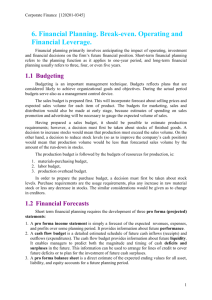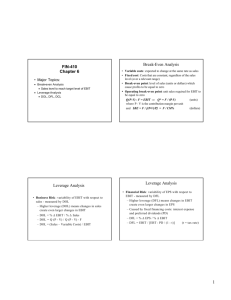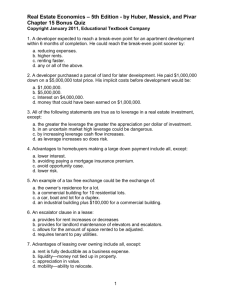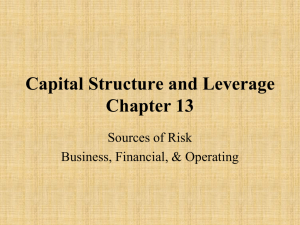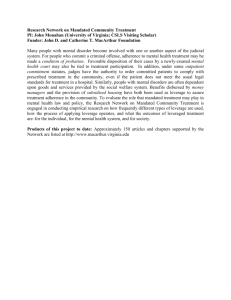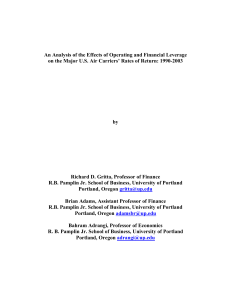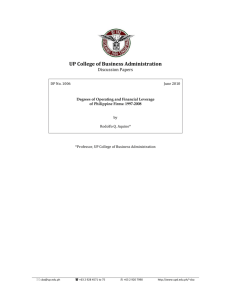7. Break-even. Operating and Financial Leverage
advertisement
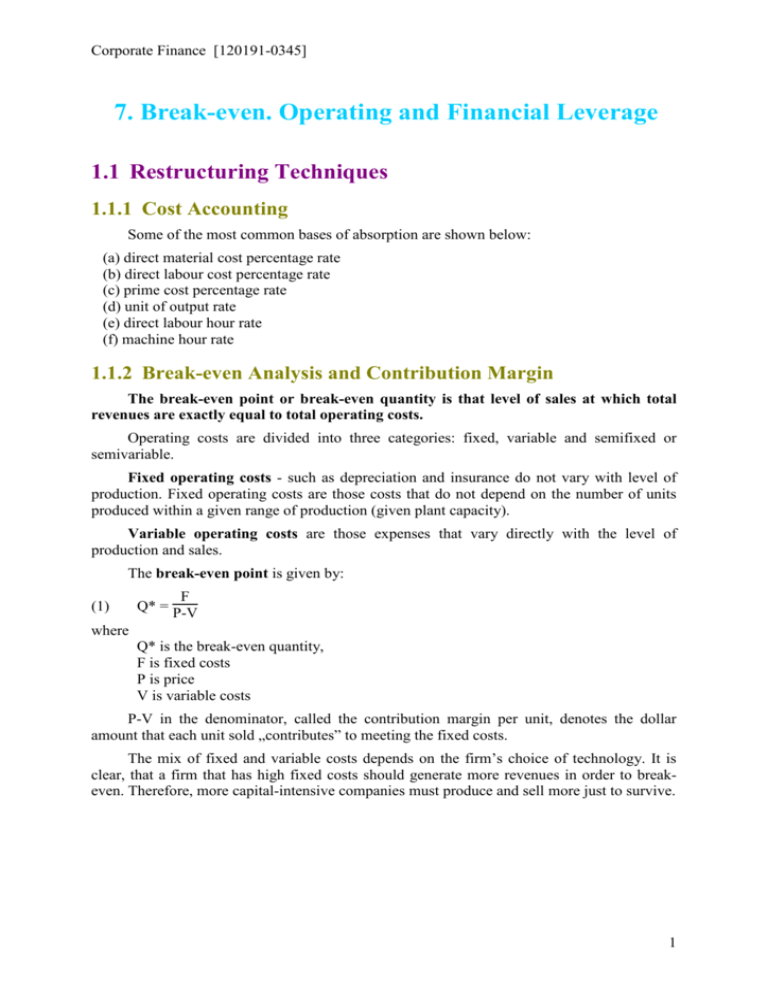
Corporate Finance [120191-0345] 7. Break-even. Operating and Financial Leverage 1.1 Restructuring Techniques 1.1.1 Cost Accounting Some of the most common bases of absorption are shown below: (a) direct material cost percentage rate (b) direct labour cost percentage rate (c) prime cost percentage rate (d) unit of output rate (e) direct labour hour rate (f) machine hour rate 1.1.2 Break-even Analysis and Contribution Margin The break-even point or break-even quantity is that level of sales at which total revenues are exactly equal to total operating costs. Operating costs are divided into three categories: fixed, variable and semifixed or semivariable. Fixed operating costs - such as depreciation and insurance do not vary with level of production. Fixed operating costs are those costs that do not depend on the number of units produced within a given range of production (given plant capacity). Variable operating costs are those expenses that vary directly with the level of production and sales. The break-even point is given by: (1) F Q* = P-V where Q* is the break-even quantity, F is fixed costs P is price V is variable costs P-V in the denominator, called the contribution margin per unit, denotes the dollar amount that each unit sold „contributes” to meeting the fixed costs. The mix of fixed and variable costs depends on the firm’s choice of technology. It is clear, that a firm that has high fixed costs should generate more revenues in order to breakeven. Therefore, more capital-intensive companies must produce and sell more just to survive. 1 Corporate Finance [120191-0345] 1.1.3 Leverage Operating Leverage Operating leverage is the extent to which a firm’s fixed production costs contribute to its total operating costs at different levels of sales. In a firm that has operating leverage, a given change in sales results in a larger change in the net operating income. The degree of operating leverage (DOL) measures the percentage change in NOI for a given percentage change in sales: (2) DOL = percentage change in NOI percentage change in sales This can be written as (3) Q (P - V) DOL = Q (P - V) - F DOL measures the sensitivity of NOI to changes in the firm’s revenues. Financial Leverage Financial leverage measures the sensitivity of the firm’s net income (NI) to changes in its net operating income (NOI). In contrast to operating leverage, which is determined by the firm’s choice of technology (fixed and variable costs), financial leverage is determined by the firm’s financing choices (the mix of debt and equity). The degree of financial leverage (DFL) measures the percentage change in net income for a given percentage change in NOI: (4) percentage change in NI DFL = percentage change in NOI This can be written as (5) Q (P - V) -F DFL = Q (P - V) - F - I where I is the interest expenses. Combined Leverage Combined leverage measures the overall sensitivity of the firm’s net income (NI) to a change in sales. The degree of combined leverage (DCL) measures the percentage change in net income for a given percentage change in sales: (6) percentage change in NI DCL = percentage change in sales This can be written as Q (P - V) (7) DCL = Q (P - V) - F - I 2 Corporate Finance [120191-0345] Relationship between Book ROA and Book ROE The return on assets (ROA) measures the accounting performance of the investment without regard to the manner in which the asset is financed. The return on equity (ROE) measures the net effects of both the investment and financing decisions. NOI (1-T) A NI Book ROE = E (8) Book ROA = (9) where A is total assets E is stockholders’ equity The relationship between ROA and ROE is shown in equation: D ROE = ROA + E ( ROA - iat) where iat = (I/D)(1-T) (10) Changes in ROA and ROE are related to DOL and DFL. (11) (12) (13) %∆ROA = DOL * %∆S %∆ROE = DFL * %∆ROA %∆ROE = DCL * %∆S Break-even, Leverage and Cash Flows The cash flow break even point is calculated as: (14) BE(CF) = F’ - Adj P-V where F’ cash fixed costs are fixed costs minus depreciation F’ = F - D Adj is adjustment factor to convert accounting based (profits) analysis to cash flow based analysis Adj = TD/(1-T) The degree of operating cash flow leverage, DOL(CF), is the sensitivity of operating cash flows (OCF) to changes in sales. It can be calculated as: (15) Q (P - V) DOL(CF) = Q (P - V) - F’ + Adj The degree of financial cash flow leverage, DFL(CF) measures the sensitivity of net cash flows (NCF) to changes in operating cash flows (OCF). It can be calculated using the following equation: (16) Q (P - V) -F’+Adj DFL(CF) = Q (P - V) - F’ - I + Adj The degree of combined cash flow leverage, DCL(CF), measures the sensitivity of net cash flows to changes in sales and is calculated as (17) Q (P - V) DCL(CF) = Q (P - V) - F’ - I + Adj 3
